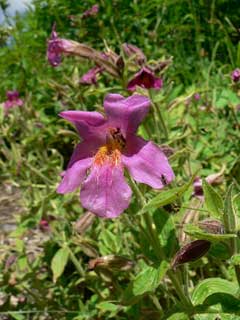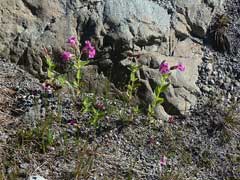 |
|
http://commons.wikimedia.org/wiki/User:Wsiegmund |
 |
| http://en.wikipedia.org/wiki/User_talk:Wsiegmund |
Translate this page:
Summary
Physical Characteristics

 Mimulus lewisii is a PERENNIAL growing to 0.6 m (2ft) by 0.5 m (1ft 8in).
Mimulus lewisii is a PERENNIAL growing to 0.6 m (2ft) by 0.5 m (1ft 8in).
See above for USDA hardiness. It is hardy to UK zone 5. It is in flower from July to August. The flowers are pollinated by Insects.
Suitable for: light (sandy), medium (loamy) and heavy (clay) soils and can grow in heavy clay soil. Suitable pH: mildly acid, neutral and basic (mildly alkaline) soils. It can grow in semi-shade (light woodland) or no shade. It prefers moist or wet soil and can grow in water.
UK Hardiness Map
US Hardiness Map
Synonyms
Plant Habitats
Woodland Garden Sunny Edge; Dappled Shade; Pond; Bog Garden;
Edible Uses
Edible Parts: Leaves
Edible Uses:
Leaves and stems - raw or cooked[172].
References More on Edible Uses
Medicinal Uses
Plants For A Future can not take any responsibility for any adverse effects from the use of plants. Always seek advice from a professional before using a plant medicinally.
Poultice
Poultice[172].
References More on Medicinal Uses
The Bookshop: Edible Plant Books
Our Latest books on Perennial Plants For Food Forests and Permaculture Gardens in paperback or digital formats.

Edible Tropical Plants
Food Forest Plants for Hotter Conditions: 250+ Plants For Tropical Food Forests & Permaculture Gardens.
More

Edible Temperate Plants
Plants for Your Food Forest: 500 Plants for Temperate Food Forests & Permaculture Gardens.
More

More Books
PFAF have eight books available in paperback and digital formats. Browse the shop for more information.
Shop Now
Other Uses
References More on Other Uses
Cultivation details
Prefers rather moist places such as damp borders, margins of streams and boggy spots[1]. Grows well in heavy clay soils. Thrives in full sun so long as the soil does not dry out[200], otherwise it is best grown in partial shade[187]. This species tolerates slightly drier conditions than M. guttatus, it prefers a rich soil in light woodland[200]. Hardy to at least -20°c[187]. Another report says that plants are only hardy in the milder parts of Britain[233]. There is some confusion over the naming of this plant, the entry on edibility may refer to M. luteus, which is closely related to this species.
References Carbon Farming Information and Carbon Sequestration Information
Temperature Converter
Type a value in the Celsius field to convert the value to Fahrenheit:
Fahrenheit:
The PFAF Bookshop
Plants For A Future have a number of books available in paperback and digital form. Book titles include Edible Plants, Edible Perennials, Edible Trees,Edible Shrubs, Woodland Gardening, and Temperate Food Forest Plants. Our new book is Food Forest Plants For Hotter Conditions (Tropical and Sub-Tropical).
Shop Now
Plant Propagation
Seed - sow spring in a greenhouse and only lightly cover the seed[200]. When they are large enough to handle, prick the seedlings out into individual pots and plant them out in the summer. If you have sufficient seed it can also be sown in situ in late spring after the last expected frosts[200]. Division in spring[200]. Very easy, large divisions can be planted out direct into their permanent positions. We have found that it is better to pot up the smaller divisions and grow them on in light shade in a cold frame until they are well established before planting them out in late spring or early summer. Cuttings of softwood, 5cm long in spring or summer[200].
Other Names
If available other names are mentioned here
Native Range
NORTHERN AMERICA: United States (Alaska (southeast), Colorado (north), Idaho, Montana (west), Oregon, Washington, Wyoming, California (north), Nevada (w. & n.), Utah (north)), Canada (Alberta, British Columbia)
Weed Potential
Right plant wrong place. We are currently updating this section.
Please note that a plant may be invasive in one area but may not in your area so it's worth checking.
Conservation Status
IUCN Red List of Threatened Plants Status :

Growth: S = slow M = medium F = fast. Soil: L = light (sandy) M = medium H = heavy (clay). pH: A = acid N = neutral B = basic (alkaline). Shade: F = full shade S = semi-shade N = no shade. Moisture: D = dry M = Moist We = wet Wa = water.
Now available:
Food Forest Plants for Mediterranean Conditions
350+ Perennial Plants For Mediterranean and Drier Food Forests and Permaculture Gardens.
[Paperback and eBook]
This is the third in Plants For A Future's series of plant guides for food forests tailored to
specific climate zones. Following volumes on temperate and tropical ecosystems, this book focuses
on species suited to Mediterranean conditions—regions with hot, dry summers and cool, wet winters,
often facing the added challenge of climate change.
Read More
Expert comment
Author
Pursh.
Botanical References
60200
Links / References
For a list of references used on this page please go here
Readers comment